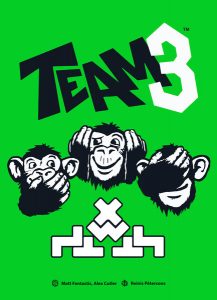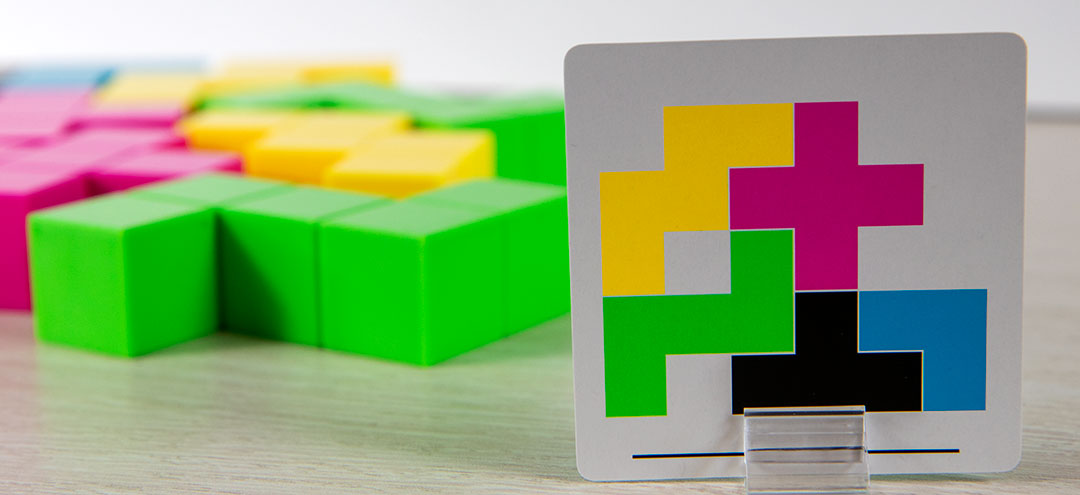 Sometimes a concept that’s so incredibly simple can be the most fun. A deck of cards, a few Tetris-style shapes, and three players. That’s all you need to play Team3, the new stacking game from publisher Brain Games (Ice Cool, Reef Route). What’s it about? Designers Alex Cutler and Matt Fantastic decided to take the old See No Evil, Hear No Evil, Say No Evil monkeys and build a game around them.
Sometimes a concept that’s so incredibly simple can be the most fun. A deck of cards, a few Tetris-style shapes, and three players. That’s all you need to play Team3, the new stacking game from publisher Brain Games (Ice Cool, Reef Route). What’s it about? Designers Alex Cutler and Matt Fantastic decided to take the old See No Evil, Hear No Evil, Say No Evil monkeys and build a game around them.
Ready to be one of those monkeys?
Gameplay Overview:
Playing Team3 requires either 3 or 6 players (up to 12 if you have both versions of the game), and is ridiculously easy to learn. For a 3 player game, each player takes on the role of either Architect, Supervisor, or Builder. The goal is for the players to cooperatively stack the shapes to match the pattern on the drawn card. The catch (there is always a catch, isn’t there), is that each player has a restriction based on their role:
- The architect is the only player that can see the card but can’t speak (they must communicate with hand gestures).
- The Supervisor watches the Architect, interprets their gestures, and tells the Builder what to do.
- The Builder must play with their eyes closed and is the only one allowed to touch the pieces and construct the required pattern.
The players have 3 minutes to correctly build the pattern, if they do, it goes in their score pile. Each card has a difficulty rating in stars (1-3). If players can complete enough cards (based on the difficulty and player count) before the fail too many cards, they win.
For a 6 player game, it’s simply team vs team. Both teams are trying to build the same shape, and the first one to do so wins.

Game Experience:
Inside Team3’s brightly colored box with its silly monkey art is a game that’s going to immediately suck you in and become one of those “just one more game” type of experiences. I was fully ready to discount this one as just another random family game but wow did we all have a ton of fun playing Team3. Each role is very different and you will want to try out all the jobs.

And it’s the restrictions that make the game so fun. Not being able to see, talk, or touch the pieces can be both incredibly frustrating, but also very engaging. I found myself constantly looking for ways to give myself an edge and overcome my limitations. As the Architect, I would make crazy hand gestures or even use the table as a base for my arms. As the builder, I would just start putting pieces together and letting the supervisor (or “middle management” as I call that role) correct me.
While Team3 only supports 6 players (unless you have both versions) it still makes a great party game. This is because it’s almost as much fun to watch the game as it is to play. We brought this one out at Gen Con this year and it was a hoot. People who weren’t actively playing were still enjoying themselves watching the players and/or criticizing/making fun of their decisions. There were also tons of laughs and cheers as one team took down another. That’s the mark of a great party game.

And with most team games, Team3 is definitely a game where the more you play with one set of teammates, the better you will be. You’ll develop your own communication style that will make you more and more efficient. I could easily see this being a tournament style game at conventions. In fact, people I’ve played this with tell me they’ve played similar style games as team building exercises (which Team3 would excel at).
My only minor gripe is that there is two versions of Team3, a green box, and a pink box. With both versions of the game, it can be played with 9 and 12 players. Which is nice, but each version of the game has a special play mode. So even if you have no desire to play at the 12 player count, you can’t get the other play mode unless you shell out the money for both versions. Personally, I would have preferred just one box and letting people buy multiple copies of the game if they want to increase the player count (which could really scale up endlessly by threes.)

Final Thoughts:
Team3 is probably one of the best party games I’ve played in a while. The premise is so simple, yet the gameplay is insanely engaging. Everyone who played wanted to try out each role, and the simple nature of the game made it easy to rotate players in and out.
Between the two play modes, I somewhat prefer six players versus three. I think I like the added challenge of trying to beat another team vs just worrying about a timer. But both modes can still provide enough challenge and enjoyment, whatever your preference is.
Final Score: 4.5 Stars – An excellent party game that is both engaging and will have you itching to play again and again.
 Hits:
Hits:
• Easy to learn
• Addictive game play
• Either fully cooperative or vs another team
• Can scale up infinitely by 3s with more copies of the game
Misses:
• Need to buy two copies to get both extra play modes.






















